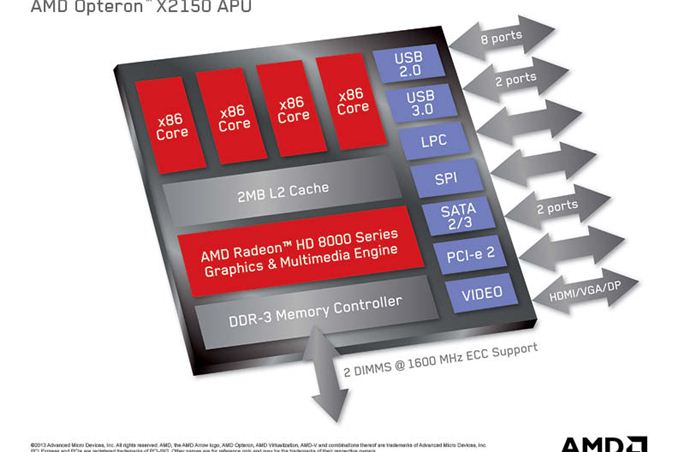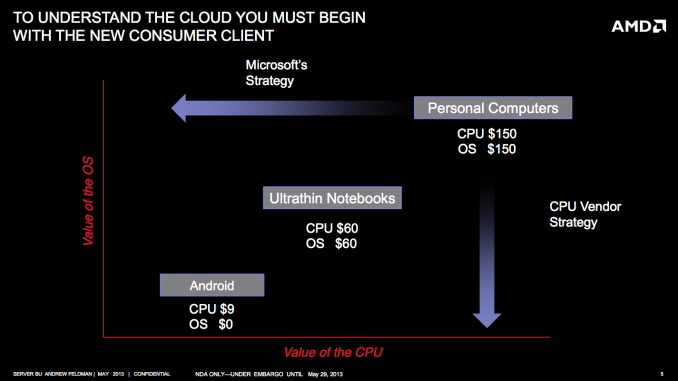AMD Opteron X1150 & X2150 "Kyoto": Kabini Heads to Servers
by Anand Lal Shimpi on May 29, 2013 10:18 AM EST- Posted in
- IT Computing
- CPUs
- AMD
- Opteron
- Kabini

Last week AMD launched its Kabini APU for clients, a quad-core Jaguar based SoC with GCN graphics aimed at entry-level and mainstream ultraportable notebooks. In our review we found significantly better CPU performance than Intel's current 32nm Atom, but lower CPU performance than low end Core based parts. Given its small die size, Kabini is price competitive with Atom but performs between it and Core - leading to some interesting value propositions for OEMs building systems around it.
Today, AMD announced that Kabini would make its way into servers in the form of an SoC codenamed Kyoto and under the Opteron brand. The Opteron X1150 CPU and X2150 APU are both quad-core Jaguar SoCs, the main difference between the two is that the X2150 has its Radeon 8000 series GPU enabled while the X1150 is CPU-only. We'll be seeing more solutions in servers with processor graphics enabled going forward, especially given how competent these integrated GPUs are at non-gaming workloads.
AMD boasts better CPU performance (single and multithreaded) than Intel's current 32nm Centerton Atom server platform, which is quite believable given what we've seen from Kabini vs. Atom.
The Kyoto parts are BGA-only, but come with extremely attractive pricing. The X2150 carries a $99 MSRP, while the X1150 is priced at $69. TDPs range between 9 - 17W (depending on CPU clock) on the X1150 with a 2GHz max CPU clock and 11 - 22W on the X2150 with a slightly lower 1.9GHz max CPU clock.
| AMD Kyoto Offerings | |||||||||||||||||||||
| CPU Cores | CPU Configurable Frequency | GPU Cores | GPU Configurable Frequency | TDP Range | 1Ku Pricing | ||||||||||||||||
| Opteron X1150 | 4 | Up to 2.0GHz | - | - | 9 - 17W | $64 | |||||||||||||||
| Opteron X2150 | 4 | Up to 1.9GHz | 128 | 266 - 600MHz | 11 - 22W | $99 | |||||||||||||||
The market for microservers based around really low power/perf CPUs like Atom or Jaguar isn't huge today, but it's growing and one that AMD already has the IP to compete in. The quick turnaround from Kabini to Kyoto is indicative of AMD's new more agile nature and focus on targeting weak points in the competition's lineup. Kyoto alone isn't going to turn AMD's server business, but compared to Atom today it's likely the best option in that power/price bracket. There's only one way to go from here, and Kyoto looks like a step in that direction.
Although not immediately related, Andrew Feldman included this slide in his presentation on Kyoto. I like it a lot so I thought I'd share it here:
In my last Kabini piece I mentioned the two non-negotiables in PC pricing, the cost of the Windows license and the cost of the Intel CPU. As the market puts even more pressure on PCs to reduce pricing, even Microsoft and Intel are forced to look for ways to maintain their margins. Once great partners, those two are presently eyeing each other's lunch.


















26 Comments
View All Comments
LemmingOverlord - Thursday, May 30, 2013 - link
Yes, as a BGA-only solution, I guess partners will be hand-picked to be server ones... I can't look at this as a teentsy server solution, but as a solution for dense server racks that require some OpenCL compute ability.How good is it really at those tasks that AMD offers as ideal? (web hosting, multimedia serving, etc...)
Has anyone come up with a consumer-oriented webserver task that is really Compute driven which could really turn these kittens into real live jaguars?
Casper42 - Thursday, February 6, 2014 - link
And here we are:http://www8.hp.com/us/en/products/proliant-servers...
HisDivineOrder - Wednesday, May 29, 2013 - link
It's time for Intel and MS to wake up, realize it's not the 1990's anymore, and come back down to Earth with the rest of the mere mortal corporations like Qualcomm, Google, etc who don't try to milk the consumer on the front end and the back end.Component manufacturers now get their profits from selling lots and lots of cheaper devices, not a few more expensive ones. Intel is high on their high margins, but in no time they're going to be surrounded by lots and lots of cheapo "good enough" devices that the market has time and again said is its heart's desire.
Intel is going to quickly become irrelevant to most consumer devices, reducing them to corporate customers and taking the whole PC hobbyist niche with them if they don't stop screwing around.
MrSpadge - Wednesday, May 29, 2013 - link
Sure, that's why we're getting a complete redesign of atom at the end of this year...krumme - Wednesday, May 29, 2013 - link
The last figure is really good, because it makes you really realize the difference that android and arm have done to the traditional x86 market. For the first time in over 20 years i just think, man it have changed, and it will never ever come back. The use of computing have fundamentally changed - jaguar/new atom whatever. The fpu of jaguar even looks like a big fat dinosaur compared to whats pushing big time all over the globe.Casper42 - Wednesday, May 29, 2013 - link
The ironic thing is that the increase in number of connected devices, those where Android and ARM have a strong foothold, are also increasing the needs for back end Compute resources in DataCenters the world over.Thats where Intel right now is dominating (and AMD is going through a 2-3 year reset).
So the more Tablets and Smartphones and etc people buy, the more Xeons Intel sells for the back end. And I am sure Anand and others can confirm that margins in that market are wayyyy better than in the desktop world.
krumme - Wednesday, May 29, 2013 - link
Yes, but the fundamental story from the figure is, the dynamics created by the new arm/android situation again leads to new situation we can not yet predict. It looks like more profit on the - as we see it - safe x86 server side and thereby Intel that can even transist their proces capacity from mobile to the serverside - as indicated by Otellini in recent interveiw.But that might be a wrong asumption just 5 years from now. Look what happened to Otellinis own predictions about what price an mainstream notebook is and would be - it just plunged, and still cant get a grib to reality.
Memristor - Wednesday, May 29, 2013 - link
What CPU-socket are they using, is it an FM2 or FT3 (BGA769)?Cerb - Thursday, May 30, 2013 - link
"The Kyoto parts are BGA-only (...)"krumme - Wednesday, May 29, 2013 - link
“What is so important about the client side is it is driving data center, which is driving servers,” Feldman saidhttp://www.pcworld.com/article/2040045/amd-bridges...
"AMD hopes to fill the need for scalable servers through Kyoto, which is AMD’s first step in the low-power processor arena, Feldman said. "